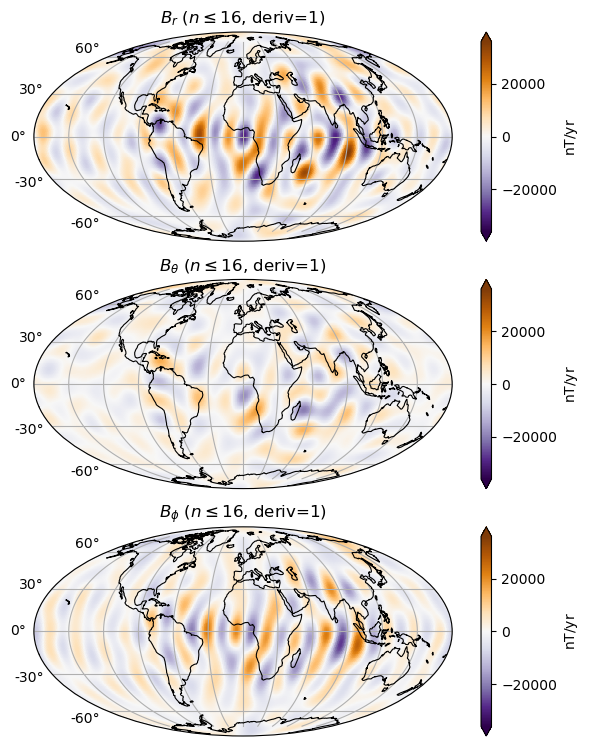ChaosMagPy#
Package authors: Clemens Kloss et al.
Resources#
Python package: chaosmagpy
Code
Documentation
Project page
Swarm Data Handbook
Finlay, C.C., Kloss, C., Olsen, N., Hammer, M. Toeffner-Clausen, L., Grayver, A and Kuvshinov, A. (2020), The CHAOS-7 geomagnetic field model and observed changes in the South Atlantic Anomaly, Earth Planets and Space 72, doi:10.1186/s40623-020-01252-9
%load_ext watermark
%watermark -i -v -p chaosmagpy,numpy,matplotlib
Python implementation: CPython
Python version : 3.11.6
IPython version : 8.18.0
chaosmagpy: 0.14
numpy : 1.26.0
matplotlib: 3.8.2
Example usage#
First we need to get the model coefficients, which can be downloaded from http://www.spacecenter.dk/files/magnetic-models/CHAOS-7/. One way to do this is to use Pooch:
%pip install pooch --quiet
WARNING: Running pip as the 'root' user can result in broken permissions and conflicting behaviour with the system package manager, possibly rendering your system unusable. It is recommended to use a virtual environment instead: https://pip.pypa.io/warnings/venv. Use the --root-user-action option if you know what you are doing and want to suppress this warning.
Note: you may need to restart the kernel to use updated packages.
import pooch
chaos_matfile = pooch.retrieve(
"http://www.spacecenter.dk/files/magnetic-models/CHAOS-7/CHAOS-7.15.mat",
known_hash="4a074dd48674eafd076fb95ac05cd1e3e034c2eb6bfe5ee3f566e3764c43bb80"
)
Downloading data from 'http://www.spacecenter.dk/files/magnetic-models/CHAOS-7/CHAOS-7.15.mat' to file '/home/jovyan/.cache/pooch/f7dc840f767b9f368ca7876196bb46b5-CHAOS-7.15.mat'.
The file, chaos_matfile, is cached by pooch so we can use it below to drive the forward code for the CHAOS model.
import numpy as np
import chaosmagpy as cp
# create full grid
radius = 3485. # km, core-mantle boundary
theta = np.linspace(0., 180., num=181) # colatitude in degrees
phi = np.linspace(-180., 180., num=361) # longitude in degrees
phi_grid, theta_grid = np.meshgrid(phi, theta)
radius_grid = radius*np.ones(phi_grid.shape)
time = cp.data_utils.mjd2000(2000, 1, 1) # modified Julian date
# create a "model" instance by loading the CHAOS model from a mat-file
model = cp.load_CHAOS_matfile(chaos_matfile)
# compute field components on the grid using the method "synth_values_tdep"
B_radius, B_theta, B_phi = model.synth_values_tdep(time, radius_grid, theta_grid, phi_grid)
B_radius
/opt/conda/lib/python3.11/site-packages/chaosmagpy/model_utils.py:505: UserWarning: Input coordinates include the poles.
warnings.warn('Input coordinates include the poles.')
array([[ 13114.07514909, 13114.07514909, 13114.07514909, ...,
13114.07514909, 13114.07514909, 13114.07514909],
[-1449320.39404283, -1453699.60257631, -1457572.82798105, ...,
-1439043.80204562, -1444435.08443306, -1449320.39404283],
[-2912809.28970337, -2918215.94338028, -2922448.49913027, ...,
-2898465.05490008, -2906226.1626899 , -2912809.28970337],
...,
[ 495526.26162097, 502429.10541553, 509334.33214343, ...,
481771.29174873, 488636.70118503, 495526.26162097],
[ 456773.00500448, 457899.48203267, 459013.0937009 , ...,
454491.55004206, 455636.18958722, 456773.00500448],
[ 365331.11634583, 365331.11634583, 365331.11634583, ...,
365331.11634583, 365331.11634583, 365331.11634583]])
We can use the built-in tools for visualising the model appropriately:
model = cp.load_CHAOS_matfile(chaos_matfile)
radius = 3485.0 # km, here core-mantle boundary
time = 0.0 # mjd2000, here Jan 1, 2000 0:00 UTC
model.plot_maps_tdep(time, radius, nmax=16, deriv=1) # plots the SV up to degree 16

For more, see https://chaosmagpy.readthedocs.io/en/master/usage.html
